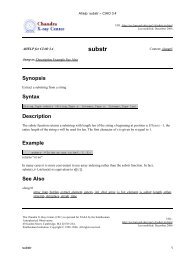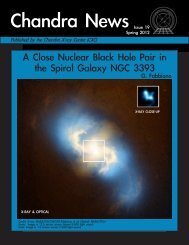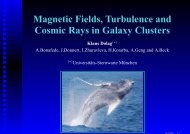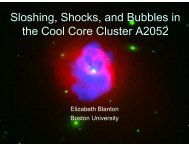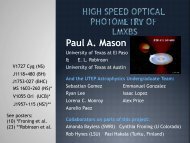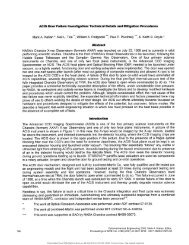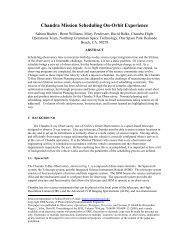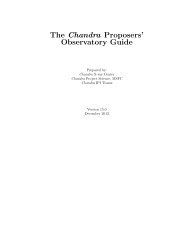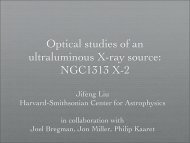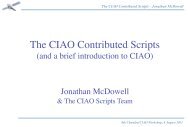Observations of Bow-Shock Pulsar Wind Nebulae - Chandra X-Ray ...
Observations of Bow-Shock Pulsar Wind Nebulae - Chandra X-Ray ...
Observations of Bow-Shock Pulsar Wind Nebulae - Chandra X-Ray ...
You also want an ePaper? Increase the reach of your titles
YUMPU automatically turns print PDFs into web optimized ePapers that Google loves.
<strong>Bow</strong> <strong>Shock</strong> PWNe: Introduction!<br />
• Formed by supersonic motion <strong>of</strong> pulsar!<br />
through surrounding medium!<br />
- can occur within host SNR or in ISM!<br />
- different Mach numbers lead to different!<br />
morphology!<br />
• Forward shock: stand-<strong>of</strong>f distance defined !<br />
by balance <strong>of</strong> wind with ambient pressure:!<br />
E ˙<br />
= ρ 2 0vPSR 4πωR0 c<br />
2 = γM 2 pamb<br />
• Termination shock – asymmetric!<br />
for M ∼ 1 – 3, R TS B /RTS F ∼ M<br />
for M >> 1, R TS B /RTS F ∼ 5 – 6!<br />
• <strong>Shock</strong>ed ambient material!<br />
- Hα in partially-neutral material!<br />
Patrick Slane (CfA)! SNRs and PWNe in the <strong>Chandra</strong> Era!<br />
forward!<br />
shock!<br />
termination !<br />
shock (front)!<br />
contact!<br />
discontinuity! termination !<br />
shock (rear)!<br />
• <strong>Shock</strong>ed wind: radio/X-ray tail!<br />
Gaensler & Slane 2006!<br />
- broad tail from material shocked at φ ∼ π/2!<br />
- narrow tail from flow along axis!<br />
- tail region broader, TS region smaller for!<br />
low-M shocks (such as within SNRs)!<br />
- Note: for X-ray bow shocks, cometary shape is!<br />
not described by classic Mach cone geometry!<br />
Boston 2009!



